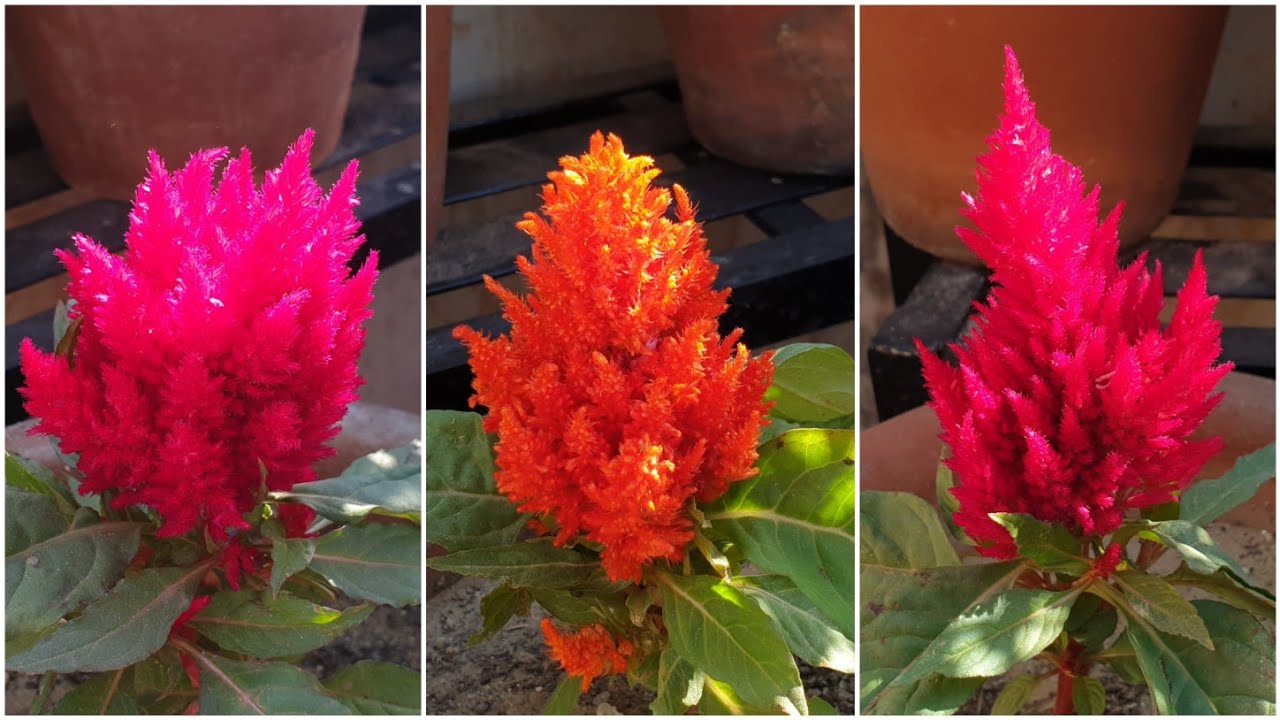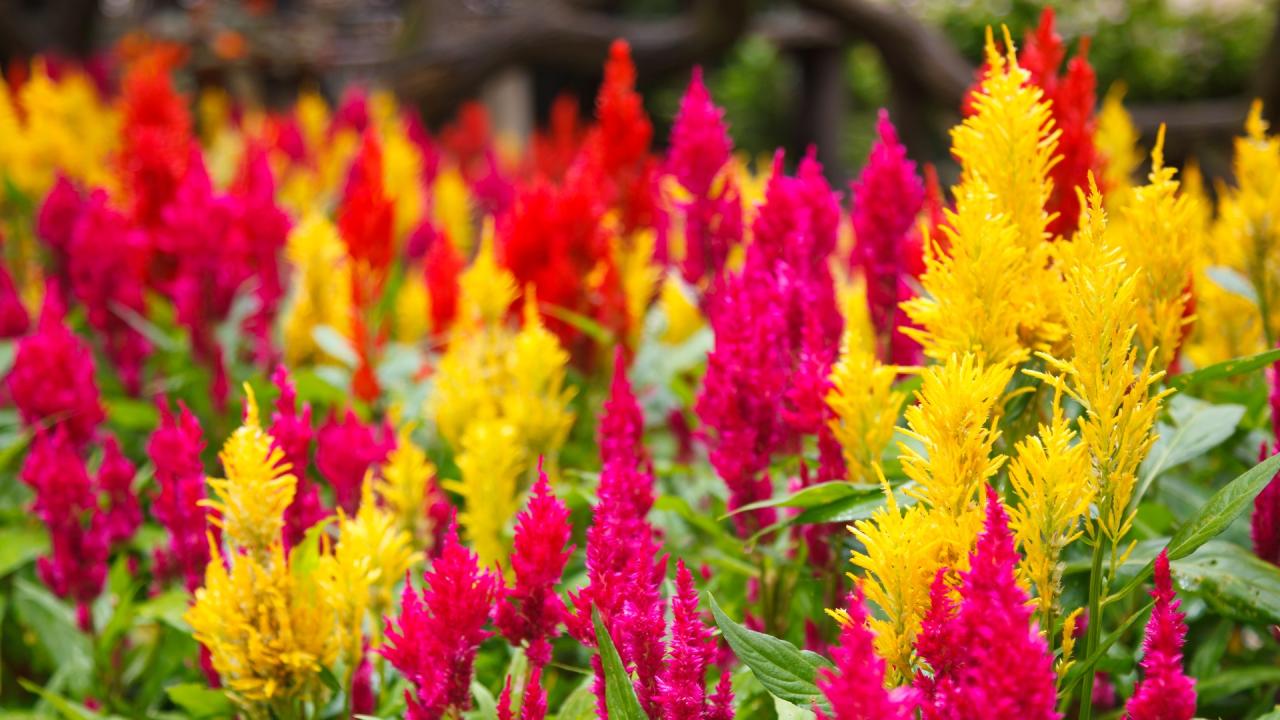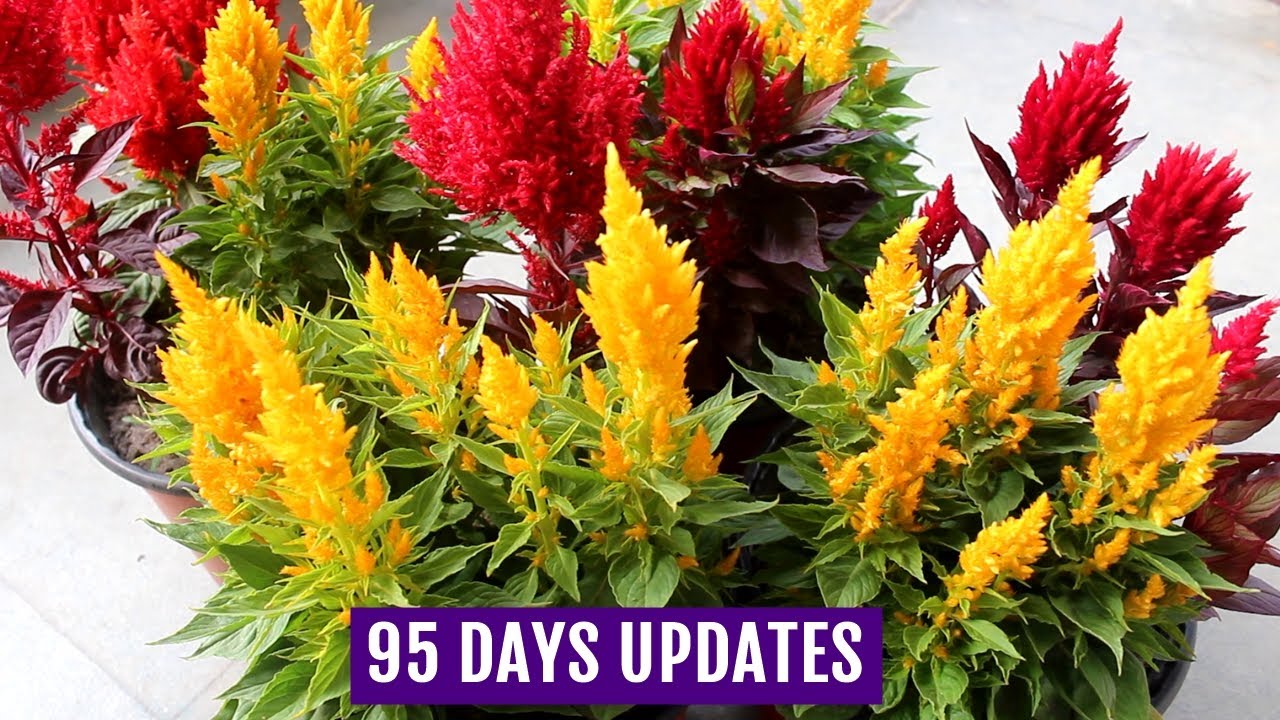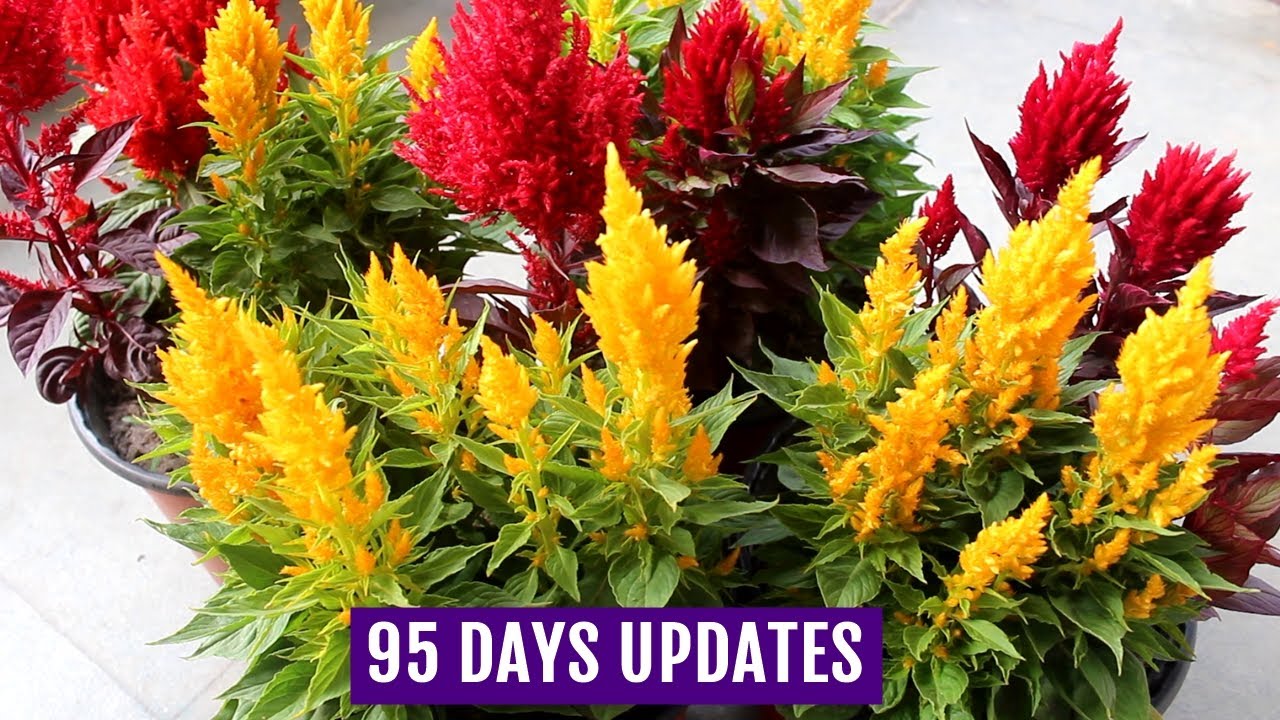The Best Fertilizers For Celosia Plant Care: A Comprehensive Guide, Celosia, with their vibrant plumes of color, are a beloved addition to gardens and landscapes. However, to achieve their full potential, these captivating plants require the right nutrients. This guide delves into the essential aspects of fertilizing celosia, providing a comprehensive understanding of the best fertilizers, application techniques, and signs of nutrient deficiency.
From understanding the specific needs of celosia to optimizing their growth through proper fertilization, this article equips gardeners with the knowledge to cultivate healthy and thriving celosia.
Celosia, also known as cockscomb or feather amaranth, are members of the Amaranthaceae family. These annuals are prized for their showy flower heads, which come in a wide array of colors, including red, orange, yellow, pink, and purple. Celosia thrives in well-drained soil with full sun to partial shade.
To ensure healthy growth and vibrant blooms, it’s essential to provide them with the right nutrients.
Understanding Celosia Plant Needs
Celosia plants, known for their vibrant and unique flower structures, thrive when provided with the right nutrients. Understanding their nutritional needs is crucial for ensuring healthy growth, abundant blooms, and vibrant colors.
Essential Nutrients for Celosia Growth
Celosia plants, like all plants, require a balanced diet of essential nutrients for optimal growth and development. These nutrients are broadly categorized into macronutrients and micronutrients.
Macronutrients
Macronutrients are required in larger quantities by plants and play a vital role in various physiological processes.
- Nitrogen (N): Nitrogen is a key component of chlorophyll, the green pigment responsible for photosynthesis. It promotes healthy foliage growth, lush green leaves, and vibrant blooms. A deficiency in nitrogen can lead to stunted growth, pale leaves, and reduced flowering.
- Phosphorus (P): Phosphorus plays a crucial role in energy production, root development, and flower bud formation. It enhances root growth, leading to better nutrient and water absorption. Phosphorus deficiency can result in slow growth, weak stems, and poor flowering.
- Potassium (K): Potassium is essential for water regulation, disease resistance, and overall plant vigor. It aids in water transport, strengthens stems, and improves the plant’s ability to withstand stress. Potassium deficiency can lead to wilting, leaf scorching, and increased susceptibility to diseases.
Micronutrients, The Best Fertilizers For Celosia Plant Care
Micronutrients are required in smaller quantities but are equally important for maintaining plant health and vitality.
- Iron (Fe): Iron is crucial for chlorophyll production and plays a role in nutrient transport. Iron deficiency can lead to chlorosis, a condition characterized by yellowing of leaves.
- Manganese (Mn): Manganese is involved in photosynthesis and respiration, contributing to healthy growth and development. Manganese deficiency can result in stunted growth and brown spots on leaves.
- Zinc (Zn): Zinc is essential for plant growth regulators and plays a role in seed production. Zinc deficiency can cause stunted growth, small leaves, and poor flower development.
Best Fertilizer Types for Celosia

Providing celosia with the right nutrients is crucial for its healthy growth and vibrant blooms. Fertilizers play a vital role in supplying these essential nutrients, but choosing the best type can be a challenge. This section explores the most popular fertilizer types for celosia, highlighting their pros and cons to help you make an informed decision.
Choosing the right fertilizer is essential for cultivating healthy and vibrant celosia plants. These colorful blooms thrive in nutrient-rich soil, making regular fertilization a key aspect of their care. To ensure optimal growth, it’s crucial to understand the specific needs of celosia and select fertilizers that provide the necessary nutrients.
For a comprehensive guide on all aspects of celosia cultivation, including planting, growing, and care, refer to How To Plant, Grow, And Care For Celosia Successfully. This resource provides valuable insights into creating the ideal environment for your celosia plants, further enhancing the benefits of proper fertilization.
Organic Fertilizers for Celosia
Organic fertilizers are derived from natural sources like compost, manure, and bone meal. They offer a slow and steady release of nutrients, promoting gradual and sustainable growth.
Pros of Organic Fertilizers
- Improved Soil Structure:Organic fertilizers enhance soil structure by increasing organic matter content, leading to better drainage and aeration.
- Nutrient Availability:They release nutrients gradually, reducing the risk of nutrient burn and promoting healthy plant growth.
- Environmental Benefits:Organic fertilizers are environmentally friendly, minimizing the risk of water and air pollution.
Cons of Organic Fertilizers
- Slower Nutrient Release:Organic fertilizers release nutrients more slowly than synthetic fertilizers, potentially delaying plant growth.
- Potential for Pests:Organic fertilizers can attract pests, requiring careful monitoring and pest management practices.
- Bulk and Storage:Organic fertilizers often come in bulk, requiring space for storage and potential for odor.
Examples of Organic Fertilizers
- Compost:A rich source of nutrients and beneficial microorganisms, compost can be applied as a top dressing or mixed into the soil.
- Manure:Animal manure provides a balanced mix of nutrients, but it’s important to use composted manure to avoid potential disease problems.
- Fish Emulsion:A liquid fertilizer rich in nitrogen, phosphorus, and potassium, fish emulsion can be applied as a foliar spray or diluted in water for watering.
Synthetic Fertilizers for Celosia
Synthetic fertilizers are manufactured from inorganic materials and provide a quick and concentrated source of nutrients. They are readily available in various formulations and ratios to meet specific plant needs.
Pros of Synthetic Fertilizers
- Fast Nutrient Release:Synthetic fertilizers provide a quick burst of nutrients, promoting rapid growth and flowering.
- Easy Application:They are available in granular, liquid, and tablet forms, making application convenient.
- Precise Nutrient Ratios:Synthetic fertilizers offer specific nutrient ratios, allowing for precise control over nutrient levels.
Cons of Synthetic Fertilizers
- Nutrient Burn:Over-application of synthetic fertilizers can lead to nutrient burn, damaging plant roots and leaves.
- Environmental Impact:Synthetic fertilizers can contribute to water and air pollution if used excessively or improperly.
- Dependence on External Sources:Reliance on synthetic fertilizers can reduce soil fertility and make plants dependent on external inputs.
Examples of Synthetic Fertilizers
- Miracle-Gro LiquaFeed:A liquid fertilizer that provides balanced nutrients for flowering plants.
- Osmocote Plus:A slow-release fertilizer that provides nutrients for up to six months.
- Scotts Turf Builder:A granular fertilizer designed for lawns, but it can also be used for celosia, although it may contain a higher nitrogen content than ideal.
Slow-Release Fertilizers for Celosia
Slow-release fertilizers are designed to release nutrients gradually over an extended period, reducing the need for frequent applications. They offer a balance between the benefits of organic and synthetic fertilizers.
Pros of Slow-Release Fertilizers
- Gradual Nutrient Release:Slow-release fertilizers provide a steady supply of nutrients, promoting sustained growth and flowering.
- Reduced Application Frequency:They require less frequent application than traditional fertilizers, saving time and effort.
- Less Environmental Impact:Slow-release fertilizers minimize nutrient leaching and runoff, reducing environmental impact.
Cons of Slow-Release Fertilizers
- Higher Initial Cost:Slow-release fertilizers are typically more expensive than traditional fertilizers.
- Potential for Nutrient Imbalance:It’s crucial to choose a slow-release fertilizer with the appropriate nutrient ratios for celosia.
- Less Control Over Nutrient Delivery:Once applied, you have less control over the rate of nutrient release.
Examples of Slow-Release Fertilizers
- Miracle-Gro Shake ‘n Feed:A granular fertilizer that releases nutrients gradually over several weeks.
- Scotts Osmocote:A controlled-release fertilizer that provides nutrients for up to six months.
- Dynamic Lifter:A slow-release fertilizer that promotes strong root development and flowering.
Fertilizer Application Techniques
Applying fertilizer to celosia plants is crucial for their healthy growth and vibrant blooms. This section provides a step-by-step guide on how to fertilize your celosia, ensuring optimal nutrient delivery for flourishing plants.
Fertilizer Application Schedule
Fertilizing celosia plants at the right time is essential for maximizing their growth and flower production. Here’s a recommended schedule for applying fertilizer:
- Spring:Begin fertilizing celosia plants in early spring, as they start to emerge from dormancy. This initial application provides the necessary nutrients for vigorous growth.
- Summer:Continue fertilizing celosia plants throughout the summer, especially during the flowering period. This regular fertilization ensures a steady supply of nutrients for continuous blooms.
- Fall:Reduce fertilization in the fall as celosia plants begin to slow down their growth and prepare for winter dormancy.
Fertilizer Dosage and Application Methods
The dosage and application methods for fertilizer depend on the type of fertilizer used. Here’s a guide for different fertilizer types:
Granular Fertilizers
Granular fertilizers are a popular choice for celosia plants due to their ease of application and slow-release properties.
Choosing the best fertilizers for your celosia plants is crucial for promoting healthy growth and vibrant blooms. To ensure optimal results, it’s essential to follow Best Practices For Keeping Your Celosia Plant Healthy , which includes providing the right nutrients and maintaining proper soil conditions.
By adhering to these practices and selecting appropriate fertilizers, you can cultivate thriving celosia plants that will add a splash of color to your garden or home.
- Dosage:Apply granular fertilizer at a rate of 1-2 tablespoons per plant, depending on the size of the plant and the fertilizer’s recommended dosage.
- Application Method:Sprinkle the granules evenly around the base of the plant, avoiding direct contact with the stem and leaves. Water the soil thoroughly after application to help the fertilizer dissolve and penetrate the roots.
Liquid Fertilizers
Liquid fertilizers are readily absorbed by celosia plants, providing a quick boost of nutrients.
- Dosage:Dilute liquid fertilizer according to the manufacturer’s instructions. Generally, a 1:10 dilution is suitable for most celosia plants.
- Application Method:Apply the diluted fertilizer directly to the soil around the base of the plant, avoiding contact with the leaves. Water the soil thoroughly after application to ensure the fertilizer reaches the roots.
Organic Fertilizers
Organic fertilizers, such as compost, manure, and fish emulsion, provide a slow and steady release of nutrients, enriching the soil and promoting healthy plant growth.
- Dosage:Apply a 2-3 inch layer of organic fertilizer around the base of the plant.
- Application Method:Gently work the fertilizer into the top layer of soil, avoiding contact with the stem and leaves. Water the soil thoroughly after application to help the fertilizer decompose and release nutrients.
Recognizing Signs of Nutrient Deficiency: The Best Fertilizers For Celosia Plant Care

While celosia plants are generally robust, they can suffer from nutrient deficiencies, leading to stunted growth and unattractive foliage. Identifying these deficiencies early allows for timely intervention and ensures your celosia thrives.
Visual Clues of Nutrient Deficiency
Understanding the visual signs of nutrient deficiency is crucial for addressing the problem effectively.
- Nitrogen Deficiency:Celosia plants with nitrogen deficiency exhibit pale green or yellow leaves, particularly on older leaves. Growth may be stunted, and the plant may appear weak and spindly.
- Phosphorus Deficiency:Phosphorus deficiency often manifests as stunted growth and purplish-red coloration on the leaves, especially on the underside. The plant may also have a weak root system.
- Potassium Deficiency:Potassium deficiency is characterized by yellowing and browning of leaf margins, particularly on older leaves. The plant may also develop brown spots or lesions on the leaves.
- Magnesium Deficiency:Magnesium deficiency often results in yellowing between the veins of leaves, leaving the veins green. This condition is known as chlorosis.
- Iron Deficiency:Iron deficiency, also causing chlorosis, leads to yellowing of young leaves, while veins remain green. This condition is commonly observed in alkaline soils.
Nutrient Deficiency Table
The following table provides a comprehensive overview of nutrient deficiency symptoms in celosia plants, along with corresponding remedies:
Nutrient Deficiency |
Symptoms |
Remedies |
|---|---|---|
Nitrogen (N) |
Pale green or yellow leaves, stunted growth, weak stems. |
Apply nitrogen-rich fertilizers, such as ammonium sulfate or urea. |
Phosphorus (P) |
Stunted growth, purplish-red coloration on leaves, weak root system. |
Apply phosphorus-rich fertilizers, such as superphosphate or bone meal. |
Potassium (K) |
Yellowing and browning of leaf margins, brown spots on leaves. |
Apply potassium-rich fertilizers, such as potassium chloride or potassium sulfate. |
Magnesium (Mg) |
Yellowing between leaf veins (chlorosis), green veins. |
Apply magnesium sulfate (Epsom salts) to the soil. |
Iron (Fe) |
Yellowing of young leaves (chlorosis), green veins. |
Apply iron chelates to the soil or spray on leaves. |
Diagnosing and Addressing Nutrient Deficiencies
- Observe the symptoms:Carefully examine your celosia plants for signs of nutrient deficiency, such as discoloration, stunted growth, or leaf abnormalities.
- Consider the soil type:Soil type plays a significant role in nutrient availability. For example, alkaline soils can lead to iron deficiency.
- Test the soil:Conduct a soil test to determine the exact nutrient levels in your soil. This provides valuable information for tailoring fertilizer applications.
- Apply appropriate fertilizer:Based on the identified nutrient deficiency, select and apply the appropriate fertilizer to correct the imbalance.
- Monitor plant response:Regularly observe your celosia plants after applying fertilizer to assess their response. If symptoms persist, adjust the fertilizer application or consult with a gardening expert.
Promoting Optimal Celosia Growth

Providing celosia plants with the right growing conditions, including the correct soil pH and consistent watering practices, is crucial for their healthy development and vibrant blooms.
Soil pH and Nutrient Availability
The soil pH plays a significant role in the availability of essential nutrients to celosia plants. Celosia thrive in slightly acidic to neutral soil, with a pH range of 6.0 to 7.0. When the soil pH falls outside this range, it can hinder the uptake of vital nutrients, leading to stunted growth and diminished flower production.
Adjusting Soil pH
To ensure optimal nutrient availability, it’s essential to adjust the soil pH if it deviates from the ideal range.
- For acidic soil(pH below 6.0): Adding lime to the soil can raise the pH. Lime is a readily available soil amendment that neutralizes acidity, making nutrients more accessible to the plant roots.
- For alkaline soil(pH above 7.0): Incorporating sulfur or peat moss can lower the pH. These amendments release hydrogen ions into the soil, gradually reducing alkalinity.
Proper Watering Practices
Consistent and adequate watering is vital for healthy celosia growth.
- Water deeply but infrequently: Allow the top inch of soil to dry out between waterings to encourage deep root development and prevent root rot.
- Avoid overwatering: Excess moisture can suffocate roots, leading to root rot and other problems. Ensure good drainage in the planting area to prevent waterlogging.
- Monitor moisture levels: Regularly check the soil moisture by sticking your finger into the soil. If it feels dry, it’s time to water.
Conclusive Thoughts
By understanding the needs of celosia, selecting the right fertilizers, and applying them correctly, gardeners can ensure their plants receive the essential nutrients for healthy growth and vibrant blooms. This guide has provided a comprehensive framework for fertilizing celosia, empowering gardeners to cultivate these captivating plants with success.
Remember to observe your celosia plants closely for any signs of nutrient deficiency and adjust your fertilization practices accordingly. With proper care and attention, your celosia will flourish, adding a touch of vibrant color to your garden.
Essential FAQs
What is the best time of year to fertilize celosia?
The best time to fertilize celosia is during the growing season, which typically runs from spring to fall. Apply fertilizer every 2-4 weeks, depending on the type of fertilizer and the growth rate of your plants.
Can I use compost as a fertilizer for celosia?
Yes, compost is an excellent organic fertilizer for celosia. It provides a slow and steady release of nutrients, improving soil structure and promoting healthy growth.
What are the signs of over-fertilization in celosia?
Over-fertilization can lead to stunted growth, leaf burn, and even death. Signs include brown or yellowed leaf tips, wilting, and a salty build-up on the soil surface.
Can I use a liquid fertilizer for celosia?
Yes, liquid fertilizers are a convenient option for fertilizing celosia. They are easily absorbed by the roots and can be applied directly to the soil or diluted in water and applied as a foliar spray.

